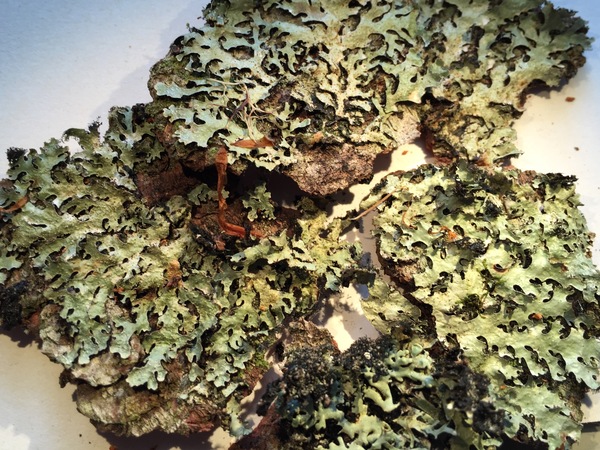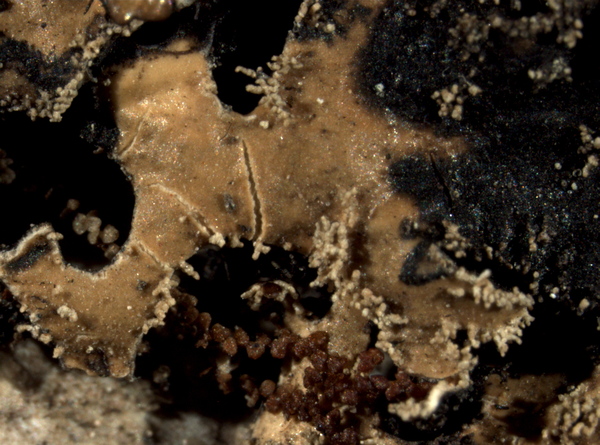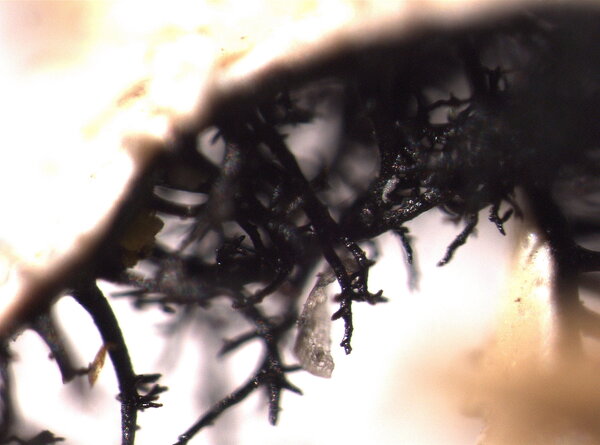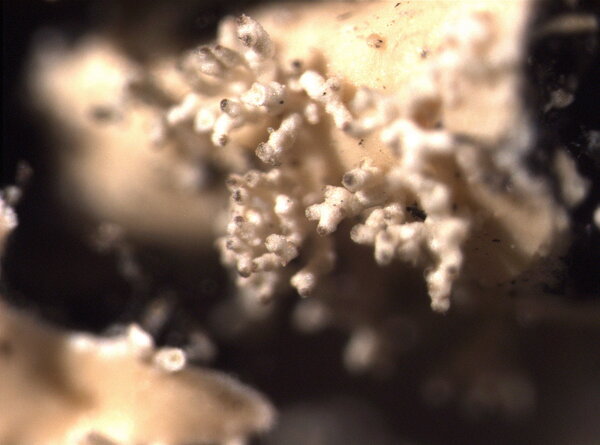Parmelia squarrosa Hale
Phytologia, 22: 29, 1971.
Synonyms:
Distribution: N - Frl (Nimis 2015).
Description: Thallus foliose, heteromerous, dorsiventral, adnate to rather loosely attached, forming 3-10 cm wide, regular rosettes. Lobes relatively thin, dichotomously branched, 1-3(-5) mm wide, usually divergent, sometimes overlapping, sublinear, with angular apices. Upper surface pale greenish-grey to whitish-grey, weakly ridged, epruinose, with a conspicuous network of laminal, whitish, at first punctiform but soon linear pseudocyphellae, and with cylindrical, laminal or marginal, simple or branched isidia that are up to 0.5 mm tall. Lower surface black, with dense, squarrosely branched (simple at margins), black rhizines. Upper cortex paraplectenchymatous, of 2-6 layers of densely packed cells, with a usually non-pored epicortex, the cell walls with isolichenan; medulla white; algal layer continuous; lower cortex paraplectenchymatous, thinner than upper cortex. Apothecia very rare, lecanorine, with a concave, brown disc and an isidiate thalline margin. Epithecium brownish; hymenium and hypothecium colourless. Asci 8-spored, clavate, Lecanora-type. Ascospores 1-celled, hyaline, broadly ellipsoid, 13-15 x 8-9 μm. Pycnidia rare, black. Spot tests: upper cortex K+ yellow (but often slowly turning orange-red due to medullary substances), C-, KC-, P- or P+ faintly yellow; medulla K+ yellow turning red, C-, KC-, P+ orange-red. Chemistry: upper cortex with atranorin; medulla with salazinic acid (major), and consalazinic acid (minor). Note: this species, which is fairly common in North America and in Japan, also occurs, albeit rarely, in very humid beech forests of the Alps. The only known Italian station is a humid montane forest hosting several extremely rare lichens with suboceanic affinities, such as Thelotrema suecicum and Usnea longissima.
Growth form: Foliose, broad lobed
Substrata: bark
Photobiont: green algae other than Trentepohlia
Reproductive strategy: mainly asexual, by isidia, or isidia-like structures (e.g. schizidia)
Most common in areas with a humid-warm climate (e.g. most of Tyrrenian Italy)
Commonnes-rarity: (info)
Alpine belt: absent
Subalpine belt: absent
Oromediterranean belt: absent
Montane belt: extremely rare
Submediterranean belt: absent
Padanian area: absent
Humid submediterranean belt: absent
Humid mediterranean belt: absent
Dry mediterranean belt: absent
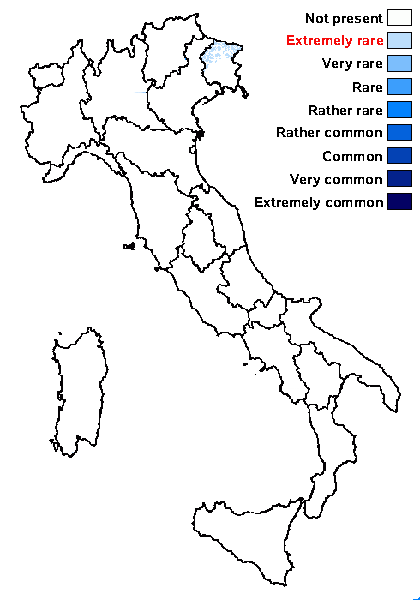
Predictive model
Herbarium samples
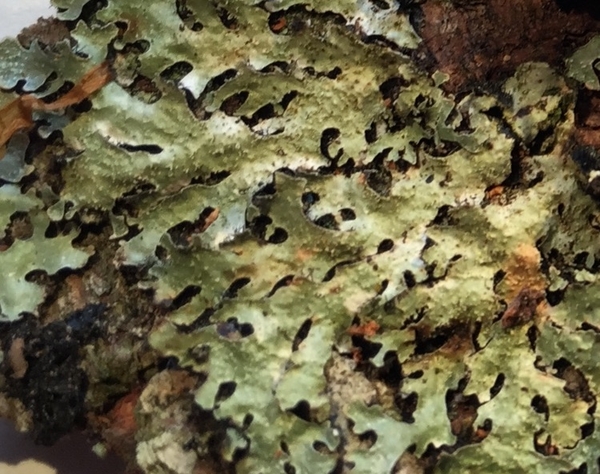

Pier Luigi Nimis; Owner: Department of Life Sciences, University of Trieste
Italy, Friuli Venezia Giulia, UD, Carnic Alps, Bosco della Stua near the Lake of Sauris (Udine), c. 1000 m
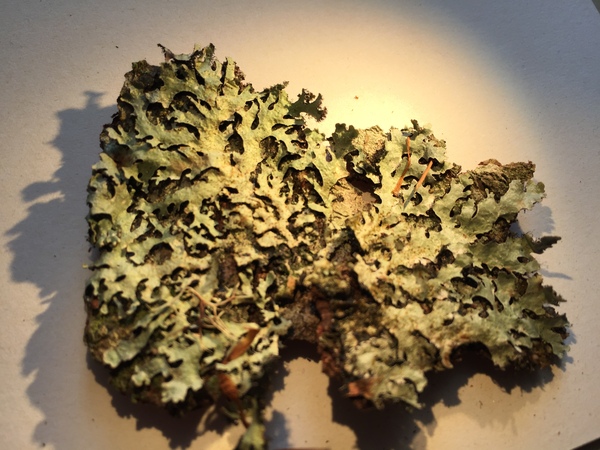

Pier Luigi Nimis; Owner: Department of Life Sciences, University of Trieste
Italy, Friuli Venezia Giulia, UD, Carnic Alps, Bosco della Stua near the Lake of Sauris (Udine), c. 1000 m
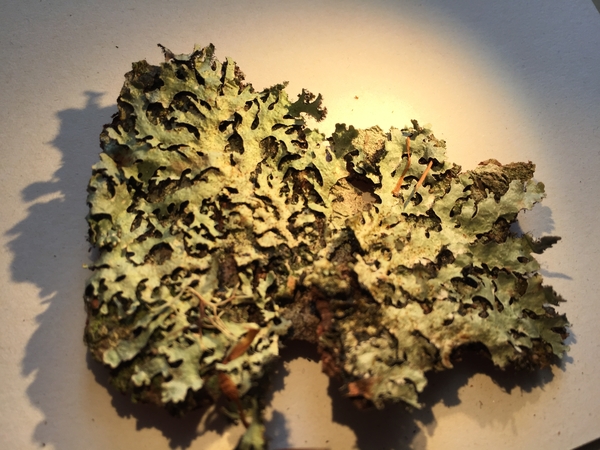

Pier Luigi Nimis; Owner: Department of Life Sciences, University of Trieste
Italy, Friuli Venezia Giulia, UD, Carnic Alps, Bosco della Stua near the Lake of Sauris (Udine), c. 1000 m
Growth form: Foliose, broad lobed
Substrata: bark
Photobiont: green algae other than Trentepohlia
Reproductive strategy: mainly asexual, by isidia, or isidia-like structures (e.g. schizidia)
Most common in areas with a humid-warm climate (e.g. most of Tyrrenian Italy)
Commonnes-rarity: (info)
Alpine belt: absent
Subalpine belt: absent
Oromediterranean belt: absent
Montane belt: extremely rare
Submediterranean belt: absent
Padanian area: absent
Humid submediterranean belt: absent
Humid mediterranean belt: absent
Dry mediterranean belt: absent

Predictive model
| Herbarium samples |


Pier Luigi Nimis; Owner: Department of Life Sciences, University of Trieste
Italy, Friuli Venezia Giulia, UD, Carnic Alps, Bosco della Stua near the Lake of Sauris (Udine), c. 1000 m


Pier Luigi Nimis; Owner: Department of Life Sciences, University of Trieste
Italy, Friuli Venezia Giulia, UD, Carnic Alps, Bosco della Stua near the Lake of Sauris (Udine), c. 1000 m


 INDEX FUNGORUM
INDEX FUNGORUM
 GBIF
GBIF
 DOLICHENS
DOLICHENS
